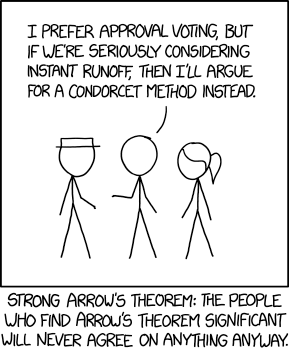Really depends on the structure. There's four options "approved" by the EU:
- No Deal
- Boris's Deal
- May's Deal
- No Brexit
They might be able to add some, like a customs union, with EU approval. But it's definitely not a binary choice anymore. So how do you fairly do a multi-choice vote? If one wanted to rig it against deals, for example, they could just go with first-past-the-post, so votes split among the deal options. Not a fair way to do it. You could also arrange it into a series of multiple binary choices - the way you group them could help ensure a particular outcome that the person setting it up intends on achieving (same effect as gerrymandering an electoral district). Also not a fair way to do it.
IMHO, I think the best way to do it might be Baldwin's Method - that is, condorcet voting with instant-runoff tiebreaking.
- Condorcet voting means you rank your choices, and then every pair of possibilities is compared against each other, with all of the other options removed, in a bunch of one-on-one races. If any possibility would win against all other possibilities in a one-on-one race, it's the condorcet winner. Just seems fair, right?
- The downside to condorcet voting is that there is not a guaranteed winner. You can get a situation where A is more popular than B, which is more popular than C, which is more popular than A. In that case, you need a resolution mechanism. IMHO, the fairest method is Schulze method - but it's a really complicated algorithm and hard to explain to people, so I think most people would see it as basically some black magic behind the scenes and mistrust it. Dodgson's method (invented by Lewis Carroll) is a bit easier to explain and still IMHO very fair, but perhaps still to complicated for the general electorate (maybe I underestimate people, however...) Instant runoff, however, is really easy to explain to people - after each round, you just remove the option that got the fewest top-ranking votes. Eventually you end up with a condorcet winner.
You can just skip the concept of a condorcet winner altoghether and go with instant runoff voting, but in practice, instant runoff is terrible as a sole mechanism - arguably worse than first-past-the-post. Let's say that there were three options:
A) Hard Left
B) Reasonable Middle Ground That Everyone Rather Likes
C) Hard Right
Let's say that your electorate can be divided into three groups:
Leftists (34% of the electorate): Thinks (C) is terrible (0/10), (A) is awesome (10/10), and B is rather nice (9/10)
Centrists (31% of the electorate): Think (A) and (C) are terrible (a mix of 0 or 1/10), and (B) is awesome (10/10)
Rightists (35% of the electorate): Thinks (A) is terrible (0/10), (C) is awesome (10/10), and B is rather nice (9/10)
So roughly 2/3rds of the electorate despise (A) and (C), while almost everyone likes (B). But instant runoff immediately kicks (B) out of the race. Only the extremists remain, and (C) slightly edges out (A) in the final round to win. This is a big problem with instant runoff: it tends to kick out broadly popular options ("everyone's second-favourite choice"), while leaving behind options that specific voting groups think are #1, even if said options are broadly unpopular among the broader electorate.
With a condorcet method, of course, the results are obvious. (B) utterly crushes both (A) and (C) in any one-on-one race, and so wins handily. As it should.
BUT.... this is of course
totally my take, and has nothing to do with what anyone in the UK will decide!




